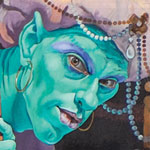
 (March 12, 1890 – 1950)
(March 12, 1890 – 1950)
Hailed as “the god of dance,” Vaslav Nijinsky earned his fame with feats of physical prowess equal to “Air Jordon.” He achieved international fame with Diaghilev's Ballets Russes in the early twentieth century. Nijinsky amazed American audiences across the country during the company’s 1916-1917 tour; in the last six weeks they toured Michigan, Ohio, Indiana and Tennessee. When Nijinsky appeared at Toledo’s Valentine Theater, the Blade reviewer remarked that “Nijinsky, the embodiment of grace and agility when in motion, proved lacking in personal appeal or charm when in repose."
Nijinsky was born in Kiev and his origins were Russian, but his heritage was Polish: his parents, Eleonora Bereda Nijinski and Thomas Lavrentievitch Nijinsky, were Polish dancers. His brother was Stanislas Nijinsky; his sister, Bronislava Nijinska, was also a dancer and brilliant choreographer for the Ballet Russe in 1921-1925.
In 1900 Nijinsky began his study at the Imperial Ballet School with Enrico Cecchetti, Nicholas Legat, and Pavel Gerdt, and made his St. Petersberg debut in 1907. He traveled to Paris in 1909 and became a premier danseur in Diaghilev’s Ballet Russe, wheree he danced the leading roles in Petrouchka, Les Sylphides, Scheherazade, and The Spectre of the Rose, all created by Micheal Fokine, a revolutionary choreographer dedicated to breaking the traditions of classical ballet and exploring new themes and dramatic contexts.
Nijinsky became a choreographer himself and is often considered the first “modern” ballet choreographer, although some of his work is more reminiscent of Modern Dance which emerged in the early twentieth century in America and Germany. The ballets he choreographed all became historic in their own time: The Afternoon of a Faun (1912), The Rite of Spring (1913) (with music by Stravinsky), Jeux (1913), and Till Eulenspiegel (1916). The Afternoon of a Faun provoked a scandalous response from the audience and critics. “We have had a faun, incontinent, with vile movements of erotic bestiality and gestures of heavy shamelessness” wrote editor Gaston Calmette of the newspaper Le Figaro. 1 The public’s offense to the suggestion of masturbation was mild compared to the opening night of The Rite of Spring which was nothing less than a riot. Witnesses reported booing, cheers, women fainting, audience members leaving, and Nijinsky screaming counts at the dancers because they could no longer hear the orchestra. At intermission the police arrived, but were unable to restore order.
Nijinsky’s artistic intensity was played out in his personal relationships, especially with Diaghilev. In 1919, Nijinsky was diagnosed with mental illness which ended his brief ten-year performance career. He lived in retirement in England and Switzerland until he died in London from kidney failure in 1950. He was laid to rest in Paris.
1. “Afternoon of the Faun Nijinsky.”
Resources
“Afternoon of the Faun Nijinsky.” Wikipedia. http://en.wikipedia.org/wiki/Afternoon_of_a_Faun_%28ballet%29
“Nijinsky, Vaslav.” The Columbia Encyclopedia, Sixth Edition 2007. High Beam Research 8 October 2007 http://www.encyclopedia.com/doc/1E1-Nijinsky.html
Ostlere, Hilary. “What becomes a Legend.” Dance Magazine 1 April 1997. http://www.encyclopedia.com/doc/1G1-19296006.html
“Vaslav Nijinsky.” Wikipedia. 8 October 2007 http://en.wikipedia.org/wiki/Vaslav_Nijinsky
Parker, Derek. Nijinsky: God of the Dance. Wellingborough: Thorsons Publishing, 1988.
“Playing the Valentine Some Big Names from the Past Played These Boards.” The Blade 3 October 1999. http://nl.newsbank.com/nl-search/we/Archives?p_action=doc&p_docid=0EAF3C7709930CA2&p_docnum=2&s_accountid=AC0107100919521111775&s_orderid=NB0107100919493518682&s_dlid=DL0107100919522911807&s_ecproduct=SBK-W3&s_subterm=Subscription%20until%3A%2010%2F16%2F2007%203%3A52%20PM&s_docsbal=Docs%20remaining%3A%202&s_subexpires=10%2F16%2F2007%203%3A52%20PM&s_docstart=3&s_docsleft=2&s_docsread=1&s_username=auburngrl&s_accountid=AC0107100919521111775&s_upgradeable=no
Nijinsky, Vaslav. The Diary of Vaslav Nijinsky. Ed. Joan Acocela. Toronto: Theater Books.
“These diaries, written in six weeks before Nijinsky’s thirtieth birthday, give us the end of his brief life as a dancer, the beginning of his thirty years as a madman. They are instructive, unbearable, necessary texts, the shadow of a legend and the lineaments of an entranced shamanism which has become inseparable from our notion of genius, even of art.” - Richard Howard.